Abstract
The 1980 Ms 6.9 Irpinia earthquake was responsible for the activation or reactivation of numerous gravitative deformations mainly hosted by clayey lithotypes, affecting wide areas of Benevento Province and the Sele and Ofanto R. Valleys. The case of Calitri offers valuable insights into a methodological approach to studying mass movements affecting human settlements. Post-earthquake investigations in Calitri involved extensive geognostic boreholes and in situ surveys, providing substantial data for lithological characterization and landslide modeling. Additionally, over the past two decades, satellite-based techniques have supported the mapping and characterization of ground deformations in this area, improving our understanding of spatiotemporal evolution. Despite these efforts, a detailed subsurface comprehensionof the tectono-stratigraphy and geometriesof gravity-induced deformation remains incomplete. This study aims to enhance our knowledge of gravity-driven deformations affecting urban areas by using deep-penetrating GroundPenetrating Radar (GPR) surveys to identify landslide-related structures, rupture surfaces, and lithological characterization of the involved lithotypes. The integration of GPR surveys with classical morphotectonic analysis led to the delineation of the main subsurface discontinuities (stratigraphy, tectonics, and gravity-related), correlating them with available geognostic data. This approach provided non-invasive, detailed insights into subsurface features and stands out as one of the rare case studies in Italy that employed the GPR method for landslide investigations.
1. Introduction
Population growth and continuous urban expansion often lead people to live in areas affected by hydrogeological and other natural hazards. Deformations induced by gravity affect territories widely and have relevant impacts on small towns and wide areas exploiting, causing fatalities and socio-economic damage [1,2,3,4].
Among the various triggers of mass movement, the role of seismic events occupies a primary position in the context of the southern Italian Apennines, as assessed by numerous records of the impact of historical earthquakes and previous studies [5,6,7].
After the Mw 6.81 1980 Irpinia earthquake [8], many mass movements were activated or re-activated in dominantly clayey lithotypes, which had a considerable areal extension and sometimes affected entire slopes. The most famous case studies are represented by what happened in the Benevento Province and the Sele and Ofanto River Valleys, especially at S. Giorgio La Molara [9,10], Senerchia [11,12], and Calitri [13,14]. Along the Ofanto R. Valley slopes, where lithostratigraphic settings concern the superimposition of ductile units on plastic ones, it is customary that rotational sliding occurs with the development and deepening of the surface of rupture in ductile units.
The Calitri landslide was a complex gravity-driven mass movement that impacted the southern slope of the hill. This case history provides intriguing insights into the methodological approach to studying mass movements that deeply interfer with human settlements. Many authors have investigated the Calitri area after the widespread reactivation of mass movements in the days following the 1980 earthquake, demonstrating their deep-seated origin and assessing slope stability through conventional methods as well as pseudo-dynamic approaches [15,16,17,18]. After the Irpinia earthquake, to plan the reconstruction of damaged areas and design long-term structural solutions, many geognostic boreholes were drilled in areas surrounding the Calitri town center. For some of these samples, inclinometers were installed, allowing the collection of a huge amount of data useful for lithological characterization, landslide modeling, and interpretation.
Moreover, in the last two decades, different studies have been carried out on the Calitri built-up area using satellite-based techniques. Thanks to the large availability of remotely sensed data, satellite imagery for almost 30 years is accessible for reconstructing the spatiotemporal evolution of landslides. In particular, using Differential Interferometric Synthetic Aperture Radar (DInSAR) techniques, slope failures were mapped and characterized in terms of the state of activity in this area at regional and local scales (e.g., [19,20]). Recently, the implementation of new advanced Multi-Temporal Interferometric Synthetic Aperture Radar (MTInSAR) algorithms allowed the detection of other deformation areas outside the already mapped landslide polygons [21]. The applicability of these techniques is particularly suitable for gravity-driven deformations with slow to very slow kinematics [22]. Moreover, continuous monitoring is an essential tool for preventing and avoiding damage caused by slope instability [23,24,25].
Although numerous investigations have been carried out on the study area, a detailed subsurface understanding of the tectono-stratigraphy and gravity-driven structures is still lacking.
For these purposes, geophysical methods have been applied in the last decade to identify landslide-related structures, surfaces of rupture, mechanical properties of the involved materials, and mass-movement kinematic styles. In recent years, Ground Penetrating Radar (GPR) has been frequently used to map subsurface features such as piping activity and sinkholes and for general stratigraphic investigations [26,27,28,29,30]. These approaches can reduce surveying time and costs. Furthermore, these techniques are noninvasive and can provide detailed insights into subsurface features. However, despite the well-known advantages, there are few examples of studies and applications on the Italian territory, which is widely affected by landslides [31,32].
This study aims to acquire new knowledge about built-up areas affected by gravity-driven deformations obtained from class deep-penetrating GPR surveys supported by classical approaches. Starting from morphotectonic analysis, we exploited the mapping of sliding surfaces with the GPR technique in an urban environment using low-frequency GPR and marking discontinuity extensions in the subsurface based on correlation with geognostic data collected.
2. Study Area
Calitri is a small town located in the Western Irpinia (Campania Region, Italy). In this sector of the Southern Apennines, the morphology is strongly dependent on structural and neotectonic evolution, and landscapes are influenced by the wide presence of terrigenous deposits. The hilly domain is characterized by low–medium acclivity slopes, and the hydrographic networks dominantly show dendritic patterns due to tectonic control. In the study area, it is possible to identify several orders of fluvial terraces, as well as ancient erosional surfaces [33].
According to information from the CARG project (https://www.isprambiente.gov.it/Media/carg/451_MELFI/Foglio.html, accessed on 8 January 2024), the Calitri hill was formed by a Pliocene regressive succession (Figure 1), including varicolored clays (AV) and gray-blue clays, sandstones with silty layers (Vallicella Formation, SAD2), and sandstones and polygenic conglomerates (Ruvo del Monte Synthem, RVM).
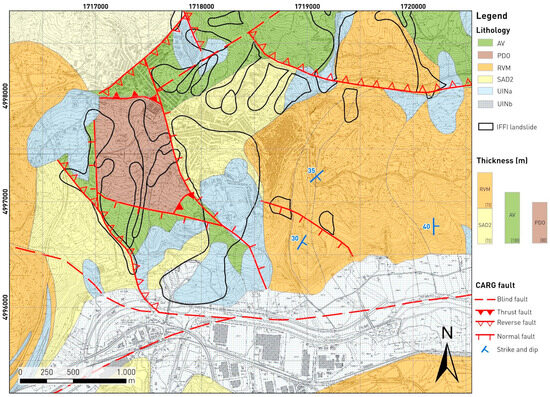
Figure 1.
Topographic basemap 1:5000 (CTR Campania) with a simplified lithological map extracted from the CARG project—Sheet 451 “Melfi”. On the right side is the thickness of the outcropping formation according to literature: PDO—Paola Doce Formation; AV—Varicolored Clays; SAD—Vallicella Formation; RVM—Ruvo del Monte Synthem; UINa—slope deposits; UINb—alluvial deposit. The landslide limits were assumed from the Official Italian Landslide Inventory Database (IFFI), updated as of 2006.
These latter lithotypes correspond to the high ground on which the ancient urban settlement and the castle ruins stand. The same stratigraphic setting can be observed in the western sector of the study area, in correspondence with the Serra Gagliano upland (Figure 1 and Figure 2).
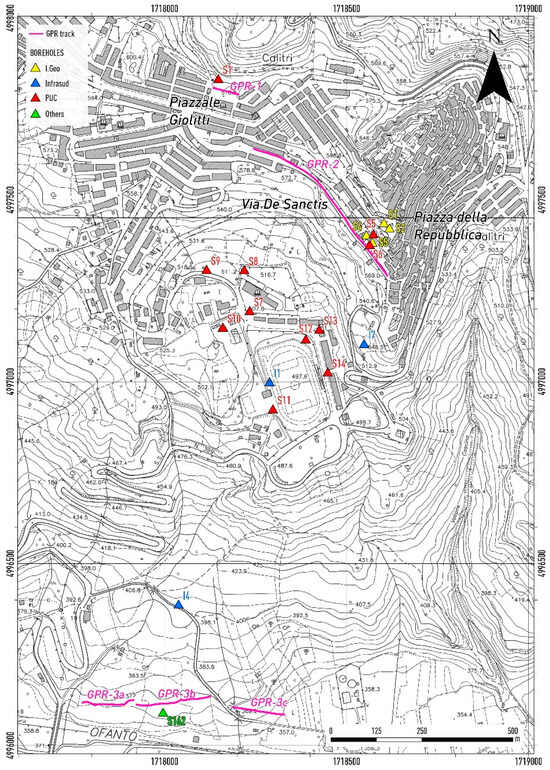
Figure 2.
Map of the study area showing the locations of the boreholes considered and the GPR investigation tracks. The different colors of the borehole markers refer to the various geognostic investigations carried out in recent decades in many research projects. Base map is derived from a 1:5000 digital topographic map (Carta Tecnica Regionale, Regione Campania, year 2005).
In addition, in the sector between the Calitri urbanized area and Serra Gagliano, calcarenites belonging to the Paola Doce “formation” (Miocene) outcrop in an area interpreted as a tectonic window [34]. AV and SAD2 clays widely crop throughout the western part of the town, consisting of a chaotic sequence of clays with reddish and green patches and stone inclusions of marly calcareous rocks. The stratigraphic relationships between the basal Varicoloured Clays Formation and other formations are by no means easy but presumably related to tectonic factors [35,36].
In this context, considering the presence of clayey lithologies with poor geotechnical characteristics in contact with silty–sandy permeable deposits, gravity-driven movements represent the main geomorphological processes in the study area.
Historical Gravity-Driven Processes and Seismicity
Taking into account the historical sources available for the study area, reports of damage that periodically affected structures stand out. The largest historical earthquake documented in the area was the 1694 Irpinia event, when the entire Calitri urban area was destroyed, and up to 1200 people died [37].
During the 20th century, chronicles report that wide sectors of the village were destroyed or seriously damaged by the earthquake of 1910; in 1930, approximately 10 houses were destroyed, and many others were damaged. Finally, the 1980 November 23rd earthquake destroyed approximately 30 buildings and damaged most of the town buildings. After the 1980 earthquake, the southern slope of the hill was affected by the reactivation of a large rototranslational deep-seated slide involving 20 M m3 of reworked silty–clayey deposits. This slide had serious environmental effects as near-vertical displacements of 1–2 m in the upper part of the slope [13].
Regarding the largest historical mass movement affecting the Calitri area, it should be pointed out that the activity of the main, eldest, landslide was not limited to periods of seismic activity: in fact, in the winter of 1951–1952, the left part of the main landslide moved, causing a fatality. The areas most damaged by the earthquakes of 1694, 1910, and 1930 and in the winter of 1951–1952 perfectly correspond, as areal extensions, to the areas damaged by the landslides induced by the earthquake of 23 November 1980 [14].
According to some historians of the ancient city, this large gravity-driven process would have been activated thousands of years ago and would have been reactivated, progressively worsened by earthquakes. According to others, it has more recent origins and dates back to 1840, which caused damage to the cathedral [38].
After the reactivation caused by the 1980 earthquake, according to Hutchinson and Del Prete (1985), the ground-cracking analysis and damage distribution were aligned with the activation of a deep-seated rototranslational mass movement. This movement’s rupture surface is estimated to lie approximately 100 m below ground level, coupled with a broad downslope earthflow. This configuration suggests the combination of various landslide movements with distinct spatiotemporal characteristics, although they contribute to an overarching, deep-seated movement. Taking into account the available borehole data, the authors proposed that the initial activation of the Calitri landslide coincided with a significant erosional phase of the Ofanto River during the lower Quaternary period.
3. Materials and Methods
The study area in Calitri was initially examined through detailed field surveys, along with geomorphological analysis using a morphotectonic approach based on aerial photo interpretation. These preliminary phases provided a fundamental understanding of the landscape and identified key areas affected by gravity-driven processes. Among the numerous boreholes drilled in the past, those situated in or near areas affected by these processes were specifically collected for further study. To obtain more comprehensive two- and three-dimensional subsurface information, the Ground Penetrating Radar (GPR) technique was accurately planned and applied. The GPR surveys provided detailed insights into subsurface structures, which were then meticulously compared to the drilling data. This comparative analysis provided a robust understanding of the subsurface conditions, significantly enhancing the accuracy of the geological and geotechnical interpretations. Figure 2 provides a comprehensive visual representation of the study area, detailing the locations of the boreholes and the GPR survey tracks.
3.1. Morphotectonic Analysis
The study area was remotely surveyed using classical aerial photo interpretation with the support of the Regione Campania aerial photogrammetric survey (year 2004) and a digital elevation model derived from a 1:5000 digital topographic map (Carta Tecnica Regionale, Regione Campania, year 2005, CTR).
To prevent misinterpretations due to wild urban settling in the study area, we analyzed azimuthal stereopairs (about 1:20,000 and 1:30,000 scale) surveyed in 1955 by the Italian “Istituto Geografico Militare” (F 186, Track 192A; F 187, Track 193A). Frame pairs were analyzed at 1X up to 8X magnification under a SOKKIA MS27 mirror stereoscope. Results were checked and mapped on the CTR at scale 1:5000. The retrieved morphological features were also digitized as vector layers in a QGIS project.
3.2. GPR Investigation and Geognostic Data
In recent years, in situ geophysical techniques for assessing the stratigraphic distribution have become commonplace in geological and geotechnical research. GPR offers the advantage of measuring physical parameters [39] relevant to movement, providing integrated information over a larger soil volume, overcoming the limitations of conventional point-scale geotechnical measurements. GPR methods, which measure the reflection of radar waves in the subsoil, have seen increased application for subsurface investigations [40,41,42], as well as for landslide investigations since the late 1970s [43,44,45].
For the present study, GPR investigations were carried out in various areas surrounding the Calitri built-up territory to assess the capability of this technique to characterize different layers in the subsurface, finding differences between geological bodies shifted by landslides and in situ bodies.
Data acquisition was conducted using the COBRA Plug-in SE 70 georadar, a sophisticated instrument equipped with a monostatic antenna with a center frequency of 80 MHz and a bandwidth ranging from 20 MHz to 140 MHz. This configuration allows versatile and detailed subsurface imaging. The instrument achieved a vertical resolution of approximately 30 cm and a horizontal resolution of approximately 90 cm, providing a high level of investigation of subsurface structures.
The georadar’s data collection capabilities are impressive, with the ability to gather 32,000 samples per second. This high sampling rate ensures that the captured data are both comprehensive and precise, significantly enhancing the clarity and detail of the subsurface images. Additionally, the georadar boasts a signal-to-noise ratio of 45 dB, which ensures that the data collected are of high quality and with minimal interference from background noise. A high signal-to-noise ratio is crucial for distinguishing different subsurface features and anomalies with greater accuracy.
One of the standout features of the COBRA Plug-in SE 70 is its depth penetration capability. With its advanced configuration, the instrument can be used to investigate depths of up to 50 m from the surface. This deep penetration makes it suitable for various applications, including geological surveys, archeological investigations, and environmental studies. The ability to reach such depths while maintaining high resolution ensures that even subtle subsurface features can be detected and analyzed. The study area was comprehensively surveyed on 8 January 2024, using advanced geophysical methods. Ground-Penetrating Radar (GPR) raw data were processed using PRISM-2 scientific software, version 2.6 (https://www.radsys.lv/en/products-soft/prism2.5+software/, accessed on 8 January 2024) along with Geolitix cloud platforms (https://www.geolitix.com/, accessed on 8 January 2024). This combination of tools enabled sophisticated data analysis and visualization, enhancing the quality of the survey results.
To ensure precise positioning, coordinates were acquired using high-accuracy GNSS instruments connected to the RING network (https://doi.org/10.13127/ring, accessed on 8 January 2024). The AV04 station served as the reference GNSS base, and data were collected in RTK (Real-Time Kinematics) mode. This method provided centimeter-level accuracy, which is crucial for detailed subsurface mapping and analysis and 3D reconstruction. The topography data obtained from the GNSS corrections were fundamental in setting the surface signal reflection to the zero-time position, ensuring accurate depth calculations and spatial orientation of the subsurface features.
The raw GPR data were processed in several steps to enhance the quality and reliability of the results. First, temporally consistent signals that could distort the data were removed using background-removal techniques. This step was essential for eliminating any static noise or artifacts that could obscure the true subsurface reflections. Additionally, the data were filtered to remove low frequencies and noise using de-wow and bandpass filters. These filters helped to isolate the relevant signals from the GPR data, allowing for a clearer and more accurate interpretation of subsurface conditions.
By combining these advanced processing techniques with high-precision GNSS data, the survey achieved high accuracy and detail.
In addition, to best reconstruct the stratigraphic setting, geognostic data from available boreholes were collected. The most recent information belongs to a dataset derived from 2006 drillings aimed at determining the lithological and geotechnical characteristics of soils in the Calitri area (Comunal Urbanistic Plan of Calitri, PUC; https://www.comune.calitri.av.it/page/968b-puccalitri, accessed on 8 January 2024). Moreover, other geognostic data from investigations carried out in the years immediately after the last seismic event were collected and considered. The multi-data approach used in this study is summarized in Figure 3.
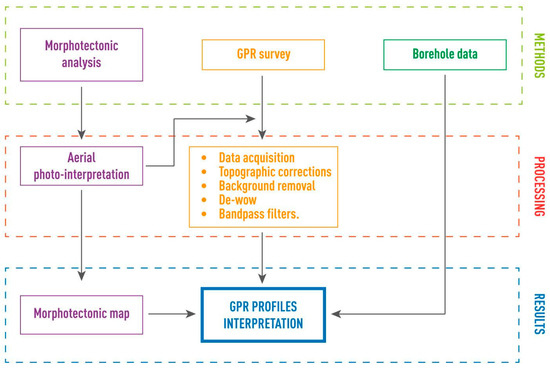
Figure 3.
The flowchart resumes the approach adopted for this study and describes how the ancillary data were used for the correct interpretation of GPR profiles.
4. Results
In this section, the outcomes achieved through aerial photo analysis and GPR surveys are illustrated in detail.
4.1. Morphotectonic Features
The results of the aerial photo interpretation are summarized in Figure 4. The morphotectonic features of the study area are mainly related to the following:
- The tectono-stratigraphic setting;
- Fluvial terraces of the Ofanto River and its tributary Ficocchia Torrent in the southernmost sector;
- Gravity-driven morphologies.
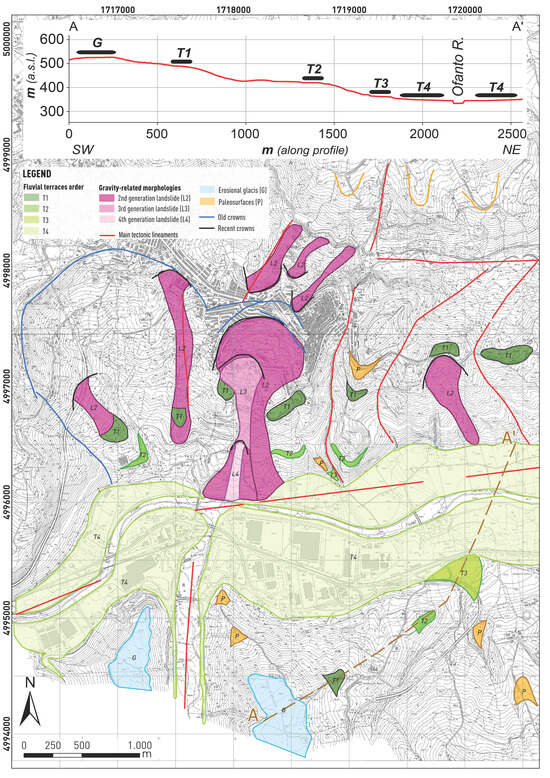
Figure 4.
Morphotectonic map derived from aerial photo-interpretation. Ofanto River-related morphologies: T1–T4, first- to fourth-order fluvial terraces, erosional glacis, and paleosurfaces. Gravity-related morphologies: landslide piles up to fourth generation; blue line, first-generation crowns of rototranslational slides; red lines, main tectonic lineaments; A-A’ brown dashed line, track of the elevation profile at the top-inset.
The stratigraphy of the pre-Quaternary substratum is dominated by the presence of a strong competence contrast among clayey units (i.e., AV and SAD2; see Section 2 and Figure 1 for details) and silty–sandy-dominated units (i.e., RVM). The main contact of these contrasting lithologies is clearly evident across Calitri Town, splitting the W-E trending hill along a roughly N-S direction, just related to the dominant strata attitude that strikes NNE-SSW with a low to moderate inclination (traces of stratification are remotely clearly recognizable). Highly competent lithologies are responsible for the SW-NE strike of the Calitri and Calvario hills and the conformal trending of the minor left tributaries of the Ofanto R. In detail, the Cascina Creek bounds the eastern slope of the Calitri hill and can be related to the outcropping of the para-conformal, tectonized contact between SAD2 and RVM. E-W, N-S, and NNE-SSW morphological lineaments are in good accordance with the tectonic setting of the area.
The overall outline of the drainage system seems to be greatly controlled by the main tectonic lineaments. Ofanto R., the main hydrological feature of the study area, appears in its mature stage, with meandering behavior along a general E-W trend.
In the study area, almost five orders of morphological surfaces can be retrieved:
- The oldest erosional surface traceable to an erosional glacis outcrops at elevations ranging from 450–530 m a.s.l. (in the southernmost sector) to 550–600 m a.s.l. in the northern sector (north of the Calitri hill);
- The remains of first- and second-order fluvial terraces of the Ofanto R., mainly erosional, are located, respectively, at about 140 m above the Ofanto R. bed (1st, m a.r.b.) and about 65–70 m a.r.b. (2nd); the third order is nowadays hardly findable (due to the anthropic exploitation of floodplains), but more clear by 1955 aerial stereopairs, they are located at about 30 m a.r.b.;
- The fourth and last order of fluvial terraces consists of wide and long strips paired at 5–10 m a.r.b. due to the presence of built-up areas; these terraces can be locally merged with third-order remains (Figure 4).
The Ficocchia Creek, located in the southernmost sector, the main right tributary of the Ofanto R., is clearly N-S oriented, following a tectonic lineament that is confidentially recognizable from aerial photo interpretation. It is worth noting that two wide remains of an erosional glacis can be found on the west and east river sides at different elevations, 70 m a.r.b. on the hydrographic left and up to 140 m a.r.b. on the right.
The central sector of the study area is dominated by landslide-related morphology. As discussed in Section 1, the Calitri area is affected by numerous gravity-driven phenomena that deeply shape its morphology. The aerial photo interpretation led to the identification of almost four generations of landslides, mainly affecting the southern side of the Calitri Ridge and, less, the northern side (Figure 4). Gravity-driven phenomena generally involve clayey and silty–clayey deposits of AV and SAD (Figure 1 and Figure 4):
- The first and oldest evidence of activity are responsible for the shaping of the Calitri-Serra Gagliano ridge.
- The second landslide generation involves the landslide pile of the first generation, which depicts an hourglass shape that indicates a mechanism of rotational sliding evolving into a flow.
- The third landslide generation is contained in the pile of previous landslides, repeating the same morphologies in a smaller size. The first to third generations are confined to the south by the Ofanto R., covering locally its fourth-order terrace (Figure 4). The first to third generations are clearly recognizable from the 1955 aerial stereopairs and are still evident in the 2004 aerial photogrammetric survey.
- The fourth and youngest landslide generation is visible only after the 2004 aerial photogrammetric survey; it is shaped and involves landslide piles from the previous generation. This landslide arrangement is clearly recognizable at the Ofanto R.- Ficocchia Creek confluence (Figure 4).
4.2. GPR Profiles Interpretation
Regarding the GPR surveys conducted in this research, we carefully selected the most representative profiles to delineate the tectono-stratigraphical setting and accurately identify the morphotectonic features. The GPR profiles were complemented by geognostic boreholes that provided crucial insights into the stratigraphic reconstruction, as depicted in Figure 2. Additionally, Figure 5, Figure 6, Figure 7, Figure 8, Figure 9 and Figure 10 summarize the main findings from the GPR interpretation, highlighting key aspects such as subsurface structures, lithological variations, and the spatial distribution of geological units. These figures illustrate the comprehensive approach taken to integrate GPR data with borehole information, enhancing our understanding of the geological and morphological dynamics in the study area.
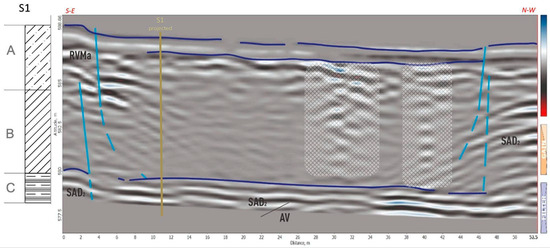
Figure 5.
GPR-1 radargram acquired in the Piazzale Giolitti parking area. Blue lines are main reflectors of contact between landslide piles and local substratum (more or less undisturbed). The cyan lines represent the possible emersion of rupture surfaces at the main scarps of the retrieved landslides. In the middle part of the radargram, considerable distortions affect the resolution due to the presence of subsurface utilities. On the left are the lithologies according to the S1 borehole: (A) fillings and altered clayey silt (RVMa); (B) brownish clayey silt with portions of crumbled limestone and sandstone; (C) compact gray silty clay (SAD2).
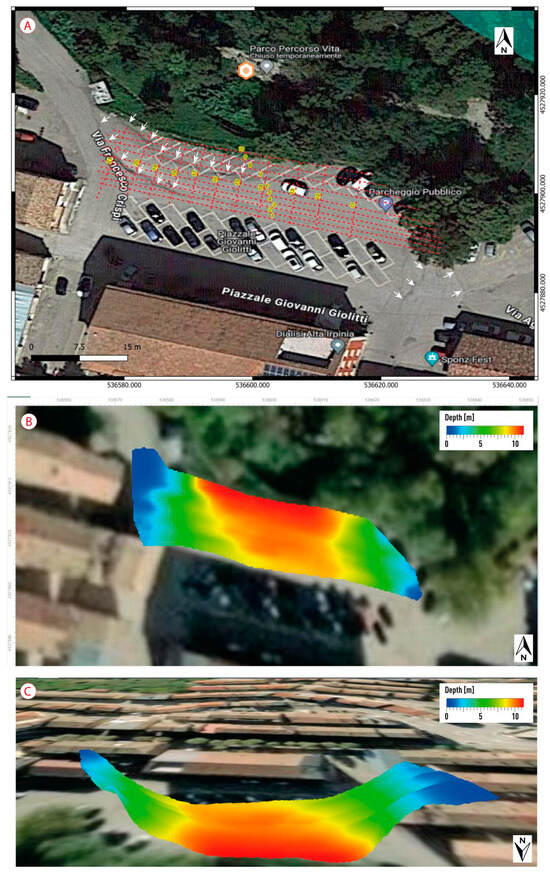
Figure 6.
(A) Three-dimensional GPR survey acquisition scheme performed at Piazzale Giolitti. The white arrows indicate evidence of surface rupture; (B) 2D model reconstruction; (C) 3D model reconstruction. The white arrows indicate visible cracks in the pavement. The colored depth scale refers to the separation landslide surface reconstructed through IDW interpolation of the depth data derived from the GPR 3D dataset (blue = 0 m, red = −10 m below ground). Data were post-processed in Geolitix environment (© 2024 Geolitix Technologies Inc., Vancouver, BC, Canada).
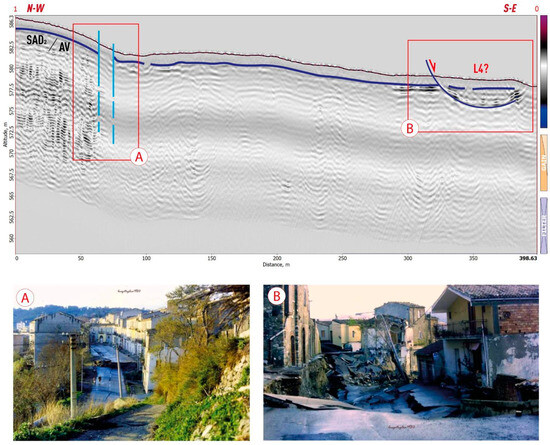
Figure 7.
A GPR-2 radargram acquired along Via De Sanctis. In correspondence with the slope break, substantial interruption in the reflector continuity can be noted. The final part of the profile contains other strong signals associated with the latest landslide reactivation, involving the southern part of the town. The blue lines represent the main reflectors of the contact between landslide piles and local substratum (more or less undisturbed). The cyan lines represent the possible emersion of rupture surfaces at the main scarps of the retrieved landslides. Below, photos (A,B) (by Luigi Toglia) were acquired in the days following the 1980 earthquake in the sectors identified by the red boxes in the upper radargram.
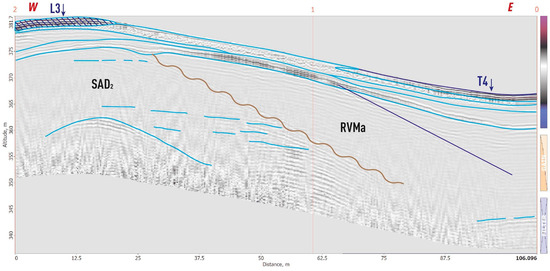
Figure 8.
GPR-3c radargram acquired in the eastern sector of the investigated area. Brown knurled line, paraconformity contact between RMVa and SAD2; light blue, sedimentary and minor geological contacts; yellow hatch, T4-order fluvial deposits; blue hatch, L3 Landslide toe pile.
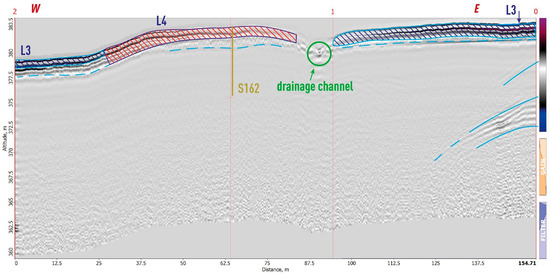
Figure 9.
GPR-3b radargram sensed in the middle part of the portion at the base of the hill: in this sector the differences between the 3rd and 4th landslide generations can be noted. The presence of a buried drainage pipe (green circle) caused a deep disturbance in the central part of the section. Blue lines are main reflectors of contact between landslide piles and local substratum (more or less undisturbed). The cyan lines represent the possible emersion of surfaces of rupture at the main scarps of the retrieved landslides.
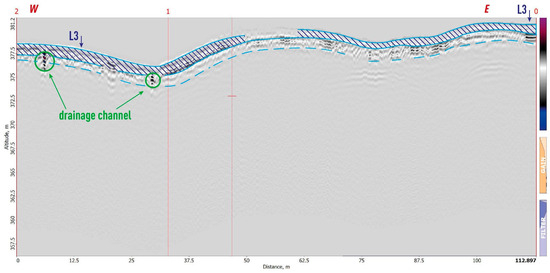
Figure 10.
GPR-3a radargram. The 3rd-order landslide pile continuously outcrops in the sector at the toe of Calitri Hill. The presence of buried drainage pipes (green circle) produced deep disturbances in the western part of the section.
The GPR-1 profile focuses on the densely urbanized sector within Calitri. Despite the challenges posed by urban infrastructure, the data resolution achieved was remarkably clear, enabling accurate delineation of subsurface features to a depth of 10 m. Within this profile, the deepest reflective horizon consistently appeared at a depth of approximately 8 m, coinciding with the paraconformity contact between clayey units such as SAD2 (or other clayey deposits associated with AV units) and the silty–sandy layers of the RVM synthem, as illustrated in Figure 5. This delineation provides valuable insights into the stratigraphic composition and structural characteristics of the subsurface in this urbanized area, highlighting the continuity and integrity of geological formations.
A buried pair of high-angle discontinuities can be identified as the eldest surface of rupture associated with first-generation landslides. In addition, a shallower pair of high-angle discontinuities can also be identified. These last surfaces have clear topographic evidence that allows undoubted identification as the main scarp of a recent roto-translational landslide that affected an urban parking area and evolved into a pile flowing toward N. Figure 4 and Figure 5 visually depict these features, highlighting clear evidence of surface rupture and movement dynamics within the study area. This detailed identification and characterization of geological features is essential for assessing the hazards posed by landslides and for informing appropriate mitigation measures to ensure the safety and stability of urban infrastructure in the affected regions.
In this area, we conducted a comprehensive GPR survey using a grid-based method, which played a crucial role in generating detailed 3D reconstructions of the subsurface features. The data-collection process involved systematically moving the GPR antenna along survey lines and meticulously recording both the position and orientation at each point. Data interpretation was focused on identifying and correlating geological features relevant to the landslide dynamics, including slip surfaces, internal deformations, and lithological boundaries. These features were analyzed across multiple GPR profiles to obtain a coherent subsurface interpretation. To enhance spatial understanding, the acquired data were processed using the Inverse Distance Weighting (IDW) interpolation technique, which enabled the creation of a continuous 3D representation of buried surfaces. This approach allowed for a thorough evaluation and interpretation of various aspects of the subsurface, visualized through sections, isosurfaces, and volumetric renderings. Figure 6A shows the acquisition grid, which depicts the longitudinal and transverse lines spaced 50 cm apart, which ensured comprehensive coverage of the survey area. We focused on defining the geometry of the separation surface associated with a small rotational sliding crowned just below the parking area of P.le Giolitti.
Figure 6B and C show, respectively, the projected map view and the three-dimensional view of the surface of separation modeled starting from the 3D GPR dataset summarized in Figure 6A. In detail, in plan view (Figure 6B), the spoon-shaped geometry gradually dips toward N, and the emersion of the surface of separation is clearly recognizable as arched cracks in the P.le Giolitti paving. To help the 3D view of the modeled surface in Figure 6C, which is oriented toward S, depicting the main scarp of the landslide emerging in the paving and gently dipping into the spoon-shaped surface of separation developed up to about a 10 m depth.
A similar stratigraphic setting was identified in the GPR-2 profile (Figure 7). This profile was sensed along the main street of Calitri Town (Via De Sanctis), covering a distance of about 400 m. In the western section of GPR-2, a distinct layer of silty–clayey deposits belonging to SAD2 (or AV, as previously discussed) extends to a depth of 20 m. Within this layer, sub-vertical discontinuities are clearly visible, demarcating their contact with a reflective-free volume characterized by deeply reworked silty–clayey materials. This configuration suggests significant geological activity and sedimentary processes in the area. Moving toward the eastern edge of the profile, a shallow arched reflector can be identified. This reflector indicates small-scale gravity-related movements that affect urban structures, resulting in observable surface effects.
Figure 7 illustrates these features, providing a visual representation of the subsurface conditions and highlighting the dynamic nature of the geological processes in the study area.
A satisfying definition of the tectono-stratigraphic setting of the study area is summarized in the profiles sensed at the base of Calitri Hill, just north of the main course of Ofanto R. (Figure 8, Figure 9 and Figure 10). These profiles show the overall surface of separation of gravity-driven piles with respect to the Quaternary and pre-Quaternary substratum. Starting from west to east, in the GPR 3c profile (Figure 8), a gentle E-dipping contact is clearly marked by a strong reflection retrieved at 370–350 m a.s.l.
The curled line in Figure 8 can be associated with paraconformity, probably tectonized, contact between SAD2 clays topped by the silty–sandy portion of the RVM synthem units. The orientation of the SAD2/RVM contact aligns well with stratigraphic evidence observed in the field.
In the deepest part of the profile, minor reflections are present and are delineated by a dome-shaped boundary. This feature can be interpreted as an olistolith embedded in the SAD2 clay. The substratum is intersected by an erosional contact that delimits an approximately 10 mthick quaternary succession consisting of fluvial deposits belonging to the fourth-order terrace of the Ofanto River (which crops out to the east) intermingled with reworked ancient gravity-related accumulations, likely corresponding to the first and second generations of landslides.
At the western end of the radargram, deposits associated with the third-generation landslide cap the succession with a thickness of about 1 m (Figure 8). The identification of these deposits continues in the GPR-3b profile, as illustrated in Figure 9, where similar landslide-related deposits are observed. This detailed characterization provides a comprehensive understanding of the subsurface geological structures and their dynamic interactions.
The latter profile exhibits a somewhat lower resolution than the GPR-3c profile. The deepest reflective surface is identifiable at a depth of 370–375 m (a.s.l.) and is likely associated with a hypothetical olistolith embedded within the SAD2 unit, which otherwise shows minimal significant reflectors in this region.
The substratum of GPR 3b is still cut off by an erosional contact that delimitates an approximately 10 mthick quaternary succession made up of reworked gravity-driven shifted piles belonging to the second generations of landslides, topped by third and fourth ones. A wide disturbance resulting from the presence of a buried pipeline prevented the delimitation of the eastern bound of the fourth-generation landslide pile (Figure 9).
The presence of the surface of separation of the fourth-generation pile (vs. quaternary substratum) was confirmed by the S162 geognostic borehole and related inclinometer data analyzed by [19] (see Figure 2 for borehole and GPR profile locations).
The GPR 3a (Figure 10) profile captures the western continuation of the stratigraphic setting observed in GPR 3b. Useful reflections can be recognized up to about 10 m from the topographic surface, although the presence of buried pipelines and drainage systems likely hinder deeper microwave penetration.
The succession appears to consist of extensively reworked deposits from second-generation landslide piles, topped by approximately 1 m deposits attributed to third-generation landslides.
5. Discussion
Two different approaches, specifically morphotectonic analysis and GPR investigation, were employed to better retrieve the tectono-stratigraphic setting and understand the landsliding movements affecting the urban areas of Calitri. These methodologies have proven essential for deciphering complex geological and geomorphological processes.
Regarding the primary mass movement, known as the “Calitri landslide”, which affects the southern slope of the hill, geomorphological investigations support the hypothesis proposed by Hutchinson and Del Prete (1985) as the most plausible explanation. We maintain this hypothesis by considering the following:
- The interpretation of GPR surveys does not show any evidence of the emersion of a deep surface of separation, and all the retrieved mass movements can be attributed to shallow deformations;
- No one of the considered boreholes (up to 50 m depth) contain a clear indication of the slip surface;
- The morphotectonic analysis confirmed the presence of diffuse instability in the southern slopes facing the Ofanto R. This condition has been evolving, probably since the Early Pleistocene. Locally, some strips of fluvial terraces appeared displaced and lowered in coincidence with shallow landslides.
The crown of this main landslide mechanism affecting the southern slope was probably located in the north-western portion of the Calitri old town sector, and its main axis was approximately N200-oriented. It is characterized by a roto-translational slide mechanism with dominant translational components that operates at the top of the hill on which Calitri lies. This validates the hypothesis of a complex style, with a main and deep-seated rototranslational slide associated with shallower slope instabilities, as well as the historical records.
The latter instabilities are expressed dominantly by translational slides, especially in the topmost part of the relief (location of the town), and affect many slopes surrounding the urban area. This finding agrees with inferences made from the reconstruction of post-event ground cracking and previous studies.
The pervasive shallower slope instabilities are supposed to sustain a more extensive and deep-seated landsliding process, with changes to the profile of the slope and an increase in its steepness, especially in the sector of the presumed crown (NW border of the old town).
In addition, the synthesis map in Figure 4 identifies at least four distinct landslide movements (from the oldest L1 to the most recent L4) that have affected the same area, remobilizing materials with poor geotechnical characteristics. The ancient landslide detachment zone is hypothesized to correspond to the higher areas of the town, such as Corso Matteotti and Piazza della Repubblica areas. Notably, following the 1980 earthquake, recent subvertical main scarps of 2–3 m appeared along Via De Sanctis and in the Piazza della Repubblica area. In fact, the boundaries of the L3 and L4 landslides corresponded to the reactivated movement following the earthquake of 23 November 1980 (Figure 7).
Another relevant aspect of the morphotectonic analysis was the stability of the eastern sector of the plain where the stadium was built. Previous maps [13,14,18] have included this entire area within the zone of active deformation due to the presence of ground cracks caused by the 1980 earthquake. However, a recent study based on Remote Sensing techniques [21] confirmed that the eastern edge of the plain shows no signs of instability, at least in the last decade. It is possible that very superficial detachments affected the slope immediately downstream following the earthquake, but these detachments are no longer visible today.
Concerning the northern slopes of Calitri Hill, which are part of the Cortino streams, aerial photo interpretation and analysis enabled the detection and mapping of at least three mass movements, thus confirming the IFFI database features. Among them, slope failure affecting the Piazzale Giolitti parking area was investigated by a GPR survey, and the substratum was individuated up to 10 m deep. The deepest reflective layer can be continuously noted at a depth of about 9 m following the information retrieved from the borehole data available.
Furthermore, investigations performed in the Piazzale Giolitti area allowed us to assess the reliability of the GPR data. The presence of a borehole close to the acquisition track provided crucial geognostic information for accurate interpretation. Therefore, geognostic information has once again proved crucial for a correct interpretation of the data acquired by GPR, especially in complex stratigraphic contexts, such as that of the study area. GPR surveys conducted along the Via De Sanctis and at the hill toe further underscore the value of this technique. The imagery obtained from these profiles enhanced our understanding of the correlation between different lithologies, such as Varicolored Clays (AV) and gray-blue clays, sandstones with silty layers (Vallicella Formation, SAD2), and sandstones and polygenic conglomerates (Ruvo del Monte Synthem, RVM). Moreover, the GPR surveys confirmed the presence of several generations of landslides (at least 4), which periodically affected the southern slope of the hill.
However, limitations can arise when applying GPR in urban areas. In fact, the presence of obstacles such as buildings, infrastructure, and underground utilities can compromise the spatial continuity of the survey. To this end, in the present study, the mass-movement limits in GPR sections were imaged and partially individuated, but identification of the slip zones requires ancillary data and additional information.
Despite these challenges, GPR equipment facilitates reasonably quick data acquisition, and recording dense information over large areas can yield effective results for investigating regions affected by gravity-driven processes, including urban areas. The dielectric properties of the subsoil obtained from these data are valuable during the modeling phase, providing accurate subsurface insights. This study underscores the importance of integrating GPR data with other geophysical and geological data to enhance the accuracy and reliability of subsurface investigations, particularly in complex and dynamic environments like Calitri.
6. Conclusions
In this study, the Calitri urban area, historically impacted by gravity-driven processes such as landslides, was investigated to better characterize the active morphological processes and clarify the geological materials involved. To achieve this, a morphotectonic analysis was conducted based on historical aerial photos, followed by extensive Ground-Penetrating Radar (GPR) surveys around the urban settlements. Moreover, ancillary data such as drilling logs were considered for the correct interpretation of the acquired GPR images.
The investigation on the northern slope revealed the correlation between second- and fourth-generation crowns of roto-translational slides, shedding light on the stratigraphic setting and the electromagnetic properties identified through GPR. On the southern slope of the hill, the analysis revealed at least four mass movements involving the clayey-reworked deposits. The GPR data acquired near the Ofanto River confirmed the presence of multiple landslide orders, demonstrating the complexity and extent of these gravity-driven processes.
The integrated approach employed in this study offers a promising perspective, especially in the context of urban and peri-urban environments where evidence is often scarce or rapidly erased by human activities. In this context, identifying subsurface features is crucial for understanding the full extent of geological hazards. The processed GPR data provided valuable insights into the subsurface features of the study area, significantly contributing to our understanding of the present geological and environmental conditions. This comprehensive approach ensured that the collected data were not only accurate but also highly reliable, providing a robust foundation for further analysis and decision making.
The detailed insights gained from this approach are invaluable when designing effective mitigation measures and improving risk-management strategies in areas susceptible to gravity-driven processes. Thus, the findings from Calitri offer a robust framework that can be applied to similar geologically complex and landslide-prone areas, ultimately contributing to safer and more resilient urban planning and development.
This approach enabled the authors to obtain detailed, non-invasive insights into subsurface features and stands out as one of the few case studies in Italy that used the GPR technique for landslide investigations.
Author Contributions
Conceptualization, N.A.F., P.M. and B.M.; methodology, N.A.F., P.M. and B.M.; software, N.A.F., P.M. and B.M.; validation, all; formal analysis, all; investigation, all; data curation, N.A.F., P.M. and B.M.; writing—original draft preparation, all; writing—review and editing, all; visualization, N.A.F., P.M., B.M. and R.M.; supervision, N.A.F., P.M. and B.M. All authors have read and agreed to the published version of the manuscript.
Funding
This research received no external funding.
Data Availability Statement
The original contributions presented in the study are included in the article, further inquiries can be directed to the corresponding author.
Acknowledgments
The authors would like to thank the municipal technical office of Calitri and Franco Tornillo for the material consulted and technical support. Also, thanks are expressed to Luigi Toglia for the historical photos made available. Thanks are due to Sabatino Ciarcia for the useful discussions about the stratigraphical setting of the study area.
Conflicts of Interest
The authors declare no conflicts of interest.
References
- Smyth, C.G.; Royle, S.A. Urban Landslide Hazards: Incidence and Causative Factors in Niterói, Rio de Janeiro State, Brazil. Appl. Geogr. 2000, 20, 95–118. [Google Scholar] [CrossRef]
- Lorentz, J.F.; Calijuri, M.L.; Marques, E.G.; Baptista, A.C. Multicriteria Analysis Applied to Landslide Susceptibility Mapping. Nat. Hazards 2016, 83, 41–52. [Google Scholar] [CrossRef]
- Di Napoli, M.; Miele, P.; Guerriero, L.; Annibali Corona, M.; Calcaterra, D.; Ramondini, M.; Sellers, C.; Di Martire, D. Multitemporal Relative Landslide Exposure and Risk Analysis for the Sustainable Development of Rapidly Growing Cities. Landslides 2023, 20, 1781–1795. [Google Scholar] [CrossRef]
- Xiong, H.; Ma, C.; Li, M.; Tan, J.; Wang, Y. Landslide Susceptibility Prediction Considering Land Use Change and Human Activity: A Case Study under Rapid Urban Expansion and Afforestation in China. Sci. Total Environ. 2023, 866, 161430. [Google Scholar] [CrossRef]
- Panizza, M.; Piacente, S. The Contribution of Geoscience to the EC Survey on European Historic Cities. Eng. Geol. 1990, 29, 399–401. [Google Scholar] [CrossRef]
- Del Gaudio, V.; Wasowski, J. Time Probabilistic Evaluation of Seismically Induced Landslide Hazard in Irpinia (Southern Italy). Soil Dyn. Earthq. Eng. 2004, 24, 915–928. [Google Scholar] [CrossRef]
- Guida, D.; Pelfini, M.; Santilli, M. Geomorphological and Dendrochronological Analyses of a Complex Landslide in the Southern Apennines. Geogr. Ann. Ser. A Phys. Geogr. 2008, 90, 211–226. [Google Scholar] [CrossRef]
- Rovida, A.; Locati, M.; Camassi, R.; Lolli, B.; Gasperini, P. The Italian Earthquake Catalogue CPTI15. Bull. Earthq. Eng. 2020, 18, 2953–2984. [Google Scholar] [CrossRef]
- Genevois, R.; Prestininzi, A. Deformazioni e movimenti di massa indotti dal sisma del 23.11.1980. Geol. Appl. Idrogeol. 1982, 17, 305–318. [Google Scholar]
- Esposito, E.; Guerrieri, L.; Porfido, S.; Vittori, E.; Blumetti, A.M.; Comerci, V.; Michetti, A.M.; Serva, L. Landslides Induced by Historical and Recent Earthquakes in Central-Southern Apennines (Italy): A Tool for Intensity Assessment and Seismic Hazard. In Landslide Science and Practice: Volume 5: Complex Environment; Margottini, C., Canuti, P., Sassa, K., Eds.; Springer: Berlin/Heidelberg, Germany, 2013; pp. 295–303. ISBN 978-3-642-31427-8. [Google Scholar]
- D’elia, B.; Esu, F.; Pelliegrino, A.; Pescatore, T.S. Some Effects on Natural Slope Stability Induced by the 1980 Italian Earthquake. In Proceedings of the International Conference on Soil Mechanics and Foundation Engineering, San Francisco, CA, USA, 12–16 August 1985; pp. 1943–1949. [Google Scholar]
- Savage, W.; Wasowski, J. A Plastic Flow Model for the Acquara–Vadoncello Landslide in Senerchia, Southern Italy. Eng. Geol. 2006, 83, 4–21. [Google Scholar] [CrossRef]
- Del Prete, M.; Trisorio Liuzzi, G. Risultati dello studio preliminare della frana di Calitri (AV) mobilitata dal terremoto del 23/11/1980. Geol. Appl. Idrogeol. 1981, 16, 153–165. [Google Scholar]
- Hutchinson, J.N.; Del Prete, M. Landslides at Calitri, Southern Apennines, Reactivated by the Earthquake of 23rd November 1980. Geol. Appl. Idrogeol 1985, 20, 9. [Google Scholar]
- Hutchinson, J.N. Some aspects of the morphological and geotechnical parameters of landslides, with examples drawn from Italy and elsewhere. Geol. Romana 1994, 30, 1–14. [Google Scholar]
- Gambino, P.; Guadagno, F.; Valentini, G. Aspetti di frana nell’area della Media Valle del F.Ofanto. Supplement. Rend. Lincei 1997. [Google Scholar]
- Crespellani, T.; Madiai, C.; Maugeri, M. Analisi di stabilità di un pendio in condizioni sismiche e post-sismiche. Riv. Ital. Geotec. 1996, 1, 50–59. [Google Scholar]
- Martino, S.; Scarascia Mugnozza, G. The Role of the Seismic Trigger in the Calitri Landslide (Italy): Historical Reconstruction and Dynamic Analysis. Soil Dyn. Earthq. Eng. 2005, 25, 933–950. [Google Scholar] [CrossRef]
- Calò, F.; Calcaterra, D.; Iodice, A.; Parise, M.; Ramondini, M. Assessing the Activity of a Large Landslide in Southern Italy by Ground-Monitoring and SAR Interferometric Techniques. Int. J. Remote Sens. 2012, 33, 3512–3530. [Google Scholar] [CrossRef]
- Martire, D.D.; De Luca, G.; Ramondini, M.; Calcaterra, D. Landslide-Related PS Data Interpretation by Means of Different Techniques. In Landslide Science and Practice: Volume 2: Early Warning, Instrumentation and Monitoring; Margottini, C., Canuti, P., Sassa, K., Eds.; Springer: Berlin/Heidelberg, Germany, 2013; pp. 347–355. ISBN 978-3-642-31445-2. [Google Scholar]
- Famiglietti, N.A.; Miele, P.; Defilippi, M.; Cantone, A.; Riccardi, P.; Tessari, G.; Vicari, A. Landslide Mapping in Calitri (Southern Italy) Using New Multi-Temporal InSAR Algorithms Based on Permanent and Distributed Scatterers. Remote Sens. 2024, 16, 1610. [Google Scholar] [CrossRef]
- Cruden, D.; Varnes, D. Landslide Types and Processes; Transportation Research Board; US National Academy of Sciences: Washington, DC, USA, 1996; pp. 36–57. [Google Scholar]
- Guzzetti, F.; Mondini, A.C.; Cardinali, M.; Fiorucci, F.; Santangelo, M.; Chang, K.-T. Landslide Inventory Maps: New Tools for an Old Problem. Earth-Sci. Rev. 2012, 112, 42–66. [Google Scholar] [CrossRef]
- Rosi, A.; Tofani, V.; Tanteri, L.; Tacconi Stefanelli, C.; Agostini, A.; Catani, F.; Casagli, N. The New Landslide Inventory of Tuscany (Italy) Updated with PS-InSAR: Geomorphological Features and Landslide Distribution. Landslides 2018, 15, 5–19. [Google Scholar] [CrossRef]
- Guerriero, L.; Confuorto, P.; Calcaterra, D.; Guadagno, F.M.; Revellino, P.; Di Martire, D. PS-Driven Inventory of Town-Damaging Landslides in the Benevento, Avellino and Salerno Provinces, Southern Italy. J. Maps 2019, 15, 619–625. [Google Scholar] [CrossRef]
- Hager, J.; Carnevale, M. The Application of Low Frequency GPR to Stratigraphic Investigations; Hager Geosci Inc.: Woburn, MA, USA, 2006; pp. 2–7. [Google Scholar]
- Pueyo-Anchuela, Ó.; Soriano, A.P.J.M.A.; Casas-Sainz, A.M. Characterization of Karst Hazards from the Perspective of the Doline Triangle Using GPR—Examples from Central Ebro Basin (Spain). Eng. Geol. 2009, 108, 225–236. [Google Scholar] [CrossRef]
- Rodriguez, V.; Gutiérrez, F.; Green, A.G.; Carbonel, D.; Horstmeyer, H.; Schmelzbach, C. Characterizing Sagging and Collapse Sinkholes in a Mantled Karst by Means of Ground Penetrating Radar (GPR). Environ. Eng. Geosci. 2014, 20, 109–132. [Google Scholar] [CrossRef]
- Garcia-Garcia, E.; Andrews, J.; Iriarte, E.; Sala, R.; Aranburu, A.; Hill, J.; Agirre-Mauleon, J. Geoarchaeological Core Prospection as a Tool to Validate Archaeological Interpretation Based on Geophysical Data at the Roman Settlement of Auritz/Burguete and Aurizberri/Espinal (Navarre). Geosciences 2017, 7, 104. [Google Scholar] [CrossRef]
- Zhang, F.; Liu, B.; Liu, L.; Wang, J.; Lin, C.; Yang, L.; Li, Y.; Zhang, Q.; Yang, W. Application of Ground Penetrating Radar to Detect Tunnel Lining Defects Based on Improved Full Waveform Inversion and Reverse Time Migration. Near Surf. Geophys. 2019, 17, 127–139. [Google Scholar] [CrossRef]
- Benedetto, A.; Tosti, F.; Ciampoli, L.B.; D’Amico, F. GPR Applications Across Engineering and Geosciences Disciplines in Italy: A Review. IEEE J. Sel. Top. Appl. Earth Obs. Remote Sens. 2016, 9, 2952–2965. [Google Scholar] [CrossRef]
- Perrone, A. Lessons Learned by 10 Years of Geophysical Measurements with Civil Protection in Basilicata (Italy) Landslide Areas. Landslides 2021, 18, 1499–1508. [Google Scholar] [CrossRef]
- Giannandrea, P. I Depositi Terrazzati Affioranti Nell’alta Valle Del Fiume Ofanto (Foglio n. 451 “Melfi”, Appennino Campano-lucano). Alp. Mediterr. Quat. 2004, 17, 511–521. [Google Scholar]
- Schiattarella, M.; Giannandrea, P.; Principe, C.; La Volpe, L. Note Illustrative Della Carta Geologica D’Italia Slla Scala 1:50,000—Foglio 451 MELFI. Vol. 1. ISPRA. 2016. Available online: https://iris.unibas.it/handle/11563/38484?mode=complete (accessed on 8 January 2024).
- Giannandrea, P.; Marino, M.; Romeo, M.; Schiattarella, M. Pliocene to Quaternary Evolution of the Ofanto Basin in Southern Italy: An Approach Based on the Unconformity-Bounded Stratigraphic Units. Ital. J. Geosci. 2013, 133, 27–44. [Google Scholar] [CrossRef]
- Vitale, S.; Ciarcia, S. The Dismembering of the Adria Platforms Following the Late Cretaceous-Eocene Abortive Rift: A Review of the Tectono-Stratigraphic Record in the Southern Apennines. Int. Geol. Rev. 2022, 64, 2866–2889. [Google Scholar] [CrossRef]
- Baratta, M. I Terremoti d’Italia: Saggio Di Storia, Geografia e Bibliografia Sismica Italiana; Con 136 Sismocartogrammi; Forni Editore: Sala Bolognese, Italy, 1901. [Google Scholar]
- Acocella, V. Storia di Calitri, 2nd ed.; Federico & Ardia: Naples, Italy, 1951. [Google Scholar]
- Hack, R. Geophysics for Slope Stability. Surv. Geophys. 2000, 21, 423–448. [Google Scholar] [CrossRef]
- McCann, D.M.; Forster, A. Reconnaissance Geophysical Methods in Landslide Investigations. Eng. Geol. 1990, 29, 59–78. [Google Scholar] [CrossRef]
- Sass, O.; Bell, R.; Glade, T. Comparison of GPR, 2D-Resistivity and Traditional Techniques for the Subsurface Exploration of the Öschingen Landslide, Swabian Alb (Germany). Geomorphology 2008, 93, 89–103. [Google Scholar] [CrossRef]
- Malehmir, A.; Bastani, M.; Krawczyk, C.M.; Gurk, M.; Ismail, N.; Polom, U.; Perss, L. Geophysical Assessment and Geotechnical Investigation of Quick-clay Landslides—A Swedish Case Study. Near Surf. Geophys. 2013, 11, 341–352. [Google Scholar] [CrossRef]
- Bichler, A.; Bobrowsky, P.; Best, M.; Douma, M.; Hunter, J.; Calvert, T.; Burns, R. Three-Dimensional Mapping of a Landslide Using a Multi-Geophysical Approach: The Quesnel Forks Landslide. Landslides 2004, 1, 29–40. [Google Scholar] [CrossRef]
- Glade, T.; Stark, P.; Dikau, R. Determination of Potential Landslide Shear Plane Depth Using Seismic Refraction—A Case Study in Rheinhessen, Germany. Bull. Eng. Geol. Environ. 2005, 64, 151–158. [Google Scholar] [CrossRef]
- Jongmans, D.; Garambois, S. Geophysical Investigation of Landslides: A Review. Bull. Soc. Géol. Fr. 2007, 178, 101–112. [Google Scholar] [CrossRef]
Disclaimer/Publisher’s Note: The statements, opinions and data contained in all publications are solely those of the individual author(s) and contributor(s) and not of MDPI and/or the editor(s). MDPI and/or the editor(s) disclaim responsibility for any injury to people or property resulting from any ideas, methods, instructions or products referred to in the content. |
© 2024 by the authors. Licensee MDPI, Basel, Switzerland. This article is an open access article distributed under the terms and conditions of the Creative Commons Attribution (CC BY) license (https://creativecommons.org/licenses/by/4.0/).